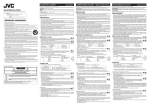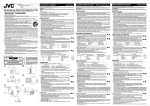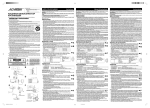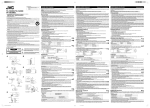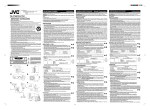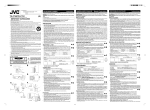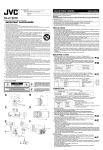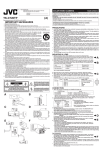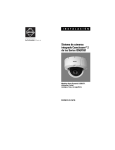Download Sensormatic RT330C3 Operating instructions
Transcript
COLOR VIDEO CAMERA RT330C3 / RT470C3 (NTSC) RT330C3-1 / RT470C3-1 (PAL) Sensormatic Electronics Europe For technical assistance please contact your local Sensormatic Representative. For Customer Use: Enter below the Serial No. which is located on the body. Retain this information for future reference. Model No. Serial No. Standard type: RT330C3 / RT330C3-1 High resolution type: RT470C3 / RT470C3-1 IMPORTANT SAFEGUARDS 7. 8. 9. 10. 11. 12. 13. 14. 15. 16. 17. 18. 19. Information for USA This device complies with Part 15 of the FCC Rules. Changes or modifications not approved by Sensormatic could void the user’s authority to operate the equipment. Read all of these instructions. Save these instructions for later use. All warnings on the product and in the operating instructions should be adhered to. Unplug this appliance system from the wall outlet before cleaning. Do not use liquid cleaners or aerosol cleaners. Use a damp cloth for cleaning. Do not use attachments not recommended by the appliance manufacturer as they may cause hazards. Do not use this appliance near water - for example, near a bathtub, washbowl, kitchen sink, or laundry tub, in a wet basement, or near a swimming pool, etc. PORTABLE CART WARNING Do not place this appliance on an unstable cart, stand, or table. The appliance may fall, (symbol provided by RETAC) causing serious injury to a child or adult, and serious damage to the appliance may fall, causing serious injury to a child or adult, and serious damage to the appliance. Use only with a cart or stand recommended by the manufacturer, or sold with the appliance. Wall or shelf mounting should follow the manufacturer’s instructions, and should use a mounting kit approved by the manufacturer. An appliance and cart combination should be moved with care. Quick stops, excessive force, and uneven surfaces may cause the appliance and cart combination to overturn. Slots and openings in the cabinet and the back or bottom are provided for ventilation, and to S3126A insure reliable operation of the appliance and to protect it from overheating, these openings must not be blocked or covered. The openings should never be blocked by placing the appliance on a bed, sofa, rug, or other similar surface. This appliance should never be placed near or over a radiator or heat register. This appliance should not be placed in a built-in installation such as a bookcase unless proper ventilation is provided. This appliance should be operated only from the type of power source indicated on the marking label. If you are not sure of the type of power supplied to your home, consult your dealer or local power company. For appliance designed to operate from battery power, refer to the operating instructions. This appliance system is equipped with a 3-wire grounding type plug (a plug having a third (grounding) pin). This plug will only fit into a grounding-type power outlet. This is a safety feature. If you are unable to insert the plug into the outlet, contact your electrician to replace your obsolete outlet. Do not defeat the safety purpose of the grounding plug. For added protection for this product during a lightning storm, or when it is left unattended and unused for long periods of time, unplug it from the wall outlet and disconnect the antenna or cable system. This will prevent damage to the product due to lightning and power-line surges. Do not allow anything to rest on the power cord. Do not locate this appliance where the cord will be abused by persons walking on it. Follow all warnings and instructions marked on the appliance. Do not overload wall outlets and extension cords as this can result in fire or electric shock. Never push objects of any kind into his appliance through cabinet slots as they mat touch dangerous voltage points or short out parts that could result in a fire or electric shock. Never spill liquid of any kind on the appliance. Do not attempt to service this appliance yourself as opening or removing covers may expose you to dangerous voltage or other hazards. Refer all servicing to qualified service personnel. Unplug his appliance from the wall outlet and refer servicing to qualified service personnel under following conditions: a. When the power cord or plug is damaged or frayed. b. If liquid has been spilled into the appliance. c. If the appliance has been exposed to rain or water. d. If the appliance does not operate normally by following the operating instructions. Adjust only those controls that are covered by the operating instructions as improper adjustment of other controls may result in damage and will often require extensive work by a qualified technician to restore the appliance to normal operation. e. If the appliance has been dropped or the cabinet has been damaged. f. When the appliance exhibits a distinct change in performance - this indicates a need for service. When replacement parts are required, be sure the service technician has used replacement parts specified by the manufacturer that have the same characteristics as the original part. Unauthorized substitutions may result in fire, electric shock, or other hazards. Upon completion of any service or repairs to this appliance, ask the service technician to perform routine safety checks to determine that the appliance is in safe operating condition. • If an AGC switch is turned on, the sensitivity increases automatically in dark places. It is not a failure when the image looks grainy. • If a zoom lens is used, check the back focus before mounting the camera. This also applies to lens ALC and LEVEL. (See the instructions on lenses for details.) • If a high-intensity object (such as a lamp) is shot, the image on the screen may have vertical lines (smear) or blur (blooming) at its periphery (especially in AES mode). This is a characteristic of the CCD, and is not a defect. • If a DC or Video type lens is used, set the automatic electronic shutter switch (AES) to OFF. If set to ON, flickering may occur. If a manual iris lens is used, set the AES to ON. • When used in hot places, vertical lines may appear on the screen of this camera. This is a characteristic of the CCD and not a failure of the camera. • The automatic tracking system may not function properly when shooting with non-standard lighting or lighting with a color temperature which exceeds the capability of the camera. In such a case, set to the “MANU” position. • If the camera subject is a single solid color (other than white), the auto white circuit will normally attempt to change this color to white. In the case of this camera, if it cannot make a correct prediction, the previous white balance setting will be maintained until the subject colors become more varied. • Where there are strong electromagnetic waves or magnetism, for example near a radio or TV transmitter, transformer, motor, etc., the picture may contain noise and the colors may be incorrect. • To save energy, be sure to turn off the system when not in use. MOUNTING A LENS 1. Before mounting a lens, check whether it is a C-mount or CS-mount lens. If a C-Mount lens is used, loosen the back-focus locking screw (M 2.6) using a Phillips head screwdriver, turn the back-focus adjusting ring with your fingers or the screwdriver and change the mounting method. 2. Dimension (b) of the lens shown in the illustration must be as shown in the table below. If (b) exceeds the value in the table, it may damage the inside of the camera or correct mounting may be impossible; never use such lenses. Do not attach the Cmount lens when camera is adjusted for CS-mount. Lens C mount lens CS mount lens Flange back (c) 17.526mm 12.5mm ∆A (See the reverse side) ∆B (See the reverse side) The F mark indicates a focal point. Lens Pin No. 1 2 3 4 DC IRIS (does not contain EE amplifier) Brake – Brake + Drive + Drive – ∆C (See the reverse side) 1 3 VIDEO IRIS (contain EE amplifier) 9.5V [max 50mA] NC VIDEO GND 2 4 CONNECTION NTSC PAL CAUTION RISK OF ELECTRIC SHOCK DO NOT OPEN CAUTION: TO REDUCE THE RISK OF ELECTRIC SHOCK. DO NOT REMOVE COVER (OR BACK). NO USER SERVICEABLE PARTS INSIDE. REFER SERVICING TO QUALIFIED SERVICE PERSONNEL. The lightning flash with arrowhead symbol, within an equi-lateral triangle, is intended to alert the user to the presence of uninsulated “dangerous voltage” within the product’s enclosure that may be of sufficient magnitude to constitute a risk of electric shock to persons. The exclamation point within an equilateral triangle is intended to alert the user to the presence of important operating and maintenance (servicing) instructions in the literature accompanying the appliance. INFORMATION (FOR CANADA) RENSEIGNEMENT (POUR LE CANADA) This Class [B] digital apparatus complies with Canadian ICES-003. Cet appareil numérique de la classe [B] est conforme à la norme NMB-003 du Canada. 1. Avant de monter l’objectif, vérifier s’il possède une monture C ou une monture CS. Pour utiliser un objectif à monture C, desserrer la vis de verrouillage de mise au point arrière (M 2,6) à l’aide d’un tournevis à tête Pillips, puis tourner la bague de réglage de mise au point arrière avec les doigts ou avec le tournevis, et changer de méthode de montage. 2. La dimension (b) de l’objectif indiquée sur le schéma doit être comme indiqué dans le tableau ci-dessous. Si (b) dépasse la valeur du tableau, cela risque d’endommager l’intérieur de la caméra ou d’empêcher un montage correct ; ne jamais utiliser ce genre d’objectifs. Ne pas fixer d’objectif à monture C lorsque l’appareil est réglé pour une monture CS. Foyer arrière (c) 17,526 mm 12,5 mm Diaphragme CC (sans amplificateur EE) Frein – Frein + Tournevis + Tournevis – (Voir au verso.) ∆B (Voir au verso.) Dimension (b) 10 mm ou moins 5,5 mm ou moins L’indication F représente le foyer. 3. Monter l’objectif sur la caméra en tournant l’objectif dans le sens des aiguilles d’une montre. Ajuster sa position. 4. Si l’objectif possède un mécanisme de diaphragme automatique avec amplificateur EE, tourner le commutateur sur le côté “VIDEO”. Si l’objectif ne renferme pas d’amplificateur EE, tourner le commutateur sur le côté “DC”. 5. Si l’objectif possède un diaphragme automatique, Raccorder le câble d’objectif après avoir vérifié la disposition des broches. Si le câble d’objectif possède une fiche de type différent, utiliser la fiche à 4 broches fournie. Objectif No. de broche 1 2 3 4 ∆A Diaphragme VIDEO (avec amplificateur EE) 9,5 V [50 mA max] NC VIDEO Terre ∆C (Voir au verso.) 1 3 2 4 power Type de CAMERA AC 24V ~ (class 2 only) or DC 12V AC 24V ~ (isolated power only) or DC12V NTSC PAL • Never connect the DC 12V and AC 24V power inputs simultaneously. • Be sure to observe the correct +, – polarity when connecting a DC 12V power input. 2. Connect to a video monitor, etc. (75Ω) 3. To install the camera onto a tripod, fixing unit, or pan/tilt unit, use the fall-preventive socket (d) shown in the illustration. Special precautions must be taken for mounting the camera on a wall or a ceiling. (See the reverse side) We are not liable for any damage caused by improper installation. 4. Installation of camera • Mounting from the bottom This camera is originally designed to be mounted from the bottom, as shown q. (See the The hole is standard photographic pan-head screw size (1/4-20 UNC). Example reverse side) the Fixing unit or Pan/Tilt unit. • Mounting from the top Remove the CAMERA MOUNTING BRACKET (e) from the bottom of the camera by removing two fixing screws as shown w. Attach the CAMERA MOUNTING BRACKET (e) to the top, then mount the camera on the Fixing Unit as shown e. Make sure that two original screws are used when mounting the CAMERA MOUNTING BRACKET (e); longer type screws (over 5mm) may damage inner components. (This camera is used indoor and under similar conditions.) ∆D Fall Prevention • Exercise maximum caution when installing the unit to the wall or ceiling. You should not engage in the installation work yourself. Ask a professional to do the job, since (See the the fall of the unit can result in injuries and accidents. reverse side) • When installing the unit on a fixer, turn table, etc., make sure to install it firmly using a rotation-preventing hole provided to prevent fall. • To prevent fall, connect the unit to a section with sufficient strength (ceiling slab or channel) using a fall prevention wire such as a wire chain and the like. Use the screw hole on the back of the unit for installation. Pay utmost attention to the length of the wire, too. • Specified screw (M3 × 6 mm) Never use any screw longer than the specified length as the inside can be damaged. ∆F VIDEOCÁMARA EN COLOR Instrucciones Gracias por adquirir nuestra videocámara en color. Para obtener los mejores resultados de su nueva videocámara, antes de utilizar la videocámara, lea cuidadosamente este manual de instrucciones, y consérvelo para futuras referencias. ADVERTENCIA: PARA EVITAR DESCARGAS ELÉCTRICAS, NO EXPONGA ESTA UNIDAD A LA LLUVIA NI A LA HUMEDAD. Debido a la modificación del diseño, los datos ofrecidos en este manual de instrucciones están sujetos a cambio sin previo aviso. PRECAUCIONES • Si pone el interruptor AGC en ON, la sensibilidad aumentará automáticamente en lugares obscuros. Cuando la imagen aparezca granulada, esto no significará mal funcionamiento. • Si utiliza un objetivo para zoom, compruebe el enfoque antes de montar la videocámara. Esto se aplica también al control automático del nivel (ALC) y al nivel (LEVEL) del objetivo. (Con respecto a los detalles, consulte las instrucciones sobre los objetivos.) • Cuando videofilme un motivo de gran intensidad (como una lámpara), la imagen de la pantalla puede tener líneas verticales (borrosidad) o desenfoque (hiperluminosidad del punto explorador) en su periferia (especialmente en el modo de obturador electrónico automático (AES). Ésta es una característica del dispositivo de transferencia de carga (CCD), y no significa defecto alguno. • Si utiliza un objetivo tipo DC o Video, ponga el interruptor del obturador electrónico automático (AES) en OFF. Si lo pusiese en ON podría producirse parpadeo. Si utiliza un objetivo de iris manual, ponga AES en ON. • Cuando utilice la videocámara en lugares cálidos, es posible que aparezcan rayas verticales en la pantalla de la misma. Esta es una característica del dispositivo de transferencia de carga (CCD), y no significa defecto alguno. • El sistema de seguimiento automático puede no funcionar adecuadamente cuando videofilme en condiciones de iluminación no estándar, o con iluminación con una temperatura de color que sobrepase la capacidad de la videocámara. En tal caso ajústelo a la posición “MANU”. • Si somete la videocámara a un solo color (que no sea el blanco), el circuito de equilibrio automático del blanco intentará normalmente cambiar este color al blanco. En el caso de esta videocámara, si no puede realizar una predicción correcta, se mantendrá el ajuste del equilibrio del blanco anterior hasta que los colores se vuelvan más variados. • Cuando haya ondas electromagnéticas o campos magnéticos intensos, por ejemplo cerca de un transmisor de radio o televisión, un transformador, un motor, etc., las imágenes pueden contener ruido y los colores pueden ser incorrectos. • Para ahorrar energía, asegúrese de apagar el sistema cuando no esté en uso. MONTAJE DE UN OBJETIVO 1. Antes de montar un objetivo, compruebe si la montura del mismo es de tipo C o CS. Si se utiliza un objetivo con montura C, afloje el tornillo de fijación de retrofoco (M 2.6) con un destornillador de cabeza Phillips, y gire el anillo de ajuste de retrofoco con sus dedos o el destornillador para cambiar el método de montaje. 2. La dimensión (b) del objetivo mostrado en la ilustración deberá ser como se indica en la tabla siguiente. Si (b) sobrepasa el valor de la tabla, es posible que se dañe el interior de la videocámara o que el montaje correcto resulte imposible. No utilice nunca estos objetivos. No instale un objetivo de montura C cuando la cámara está ajustada para montura CS. Objetivo Reborde (c) Dimensión (b) Objetivo de montura C 17,526 mm 10 mm o menos Objetivo de montura CS 12,5 mm 5,5 mm o menos La marca F indica el punto focal. 3. Monte el objetivo en la videocámara girándolo hacia la derecha. Ajuste su posición. 4. Cuando utilice un objetivo de iris automático con amplificador EE, ponga el selector en el lado “VIDEO”. Cuando el objetivo no disponga de amplificador EE, ponga el selector en el lado “DC”. 5. Si el objetivo no dispone de mecanismo de iris automático, conecte el cable del objetivo después de haber comprobado la disposición de los contactos. Si el cable posee un tipo de conector diferente, utilice el conector de 4 contactos suministrado. Objetivo Núm. de contacto 1 2 3 4 Iris DC (No posee amplificador EE) Freno – Freno + Excitación + Excitación – Iris VIDEO (Posee amplificador EE) 9,5 V [50 mA como máx.] Sin conexión VIDEO Masa ∆A (Véase el dorso) ∆B (Véase el dorso) ∆C (Véase el dorso) 1 3 2 4 CONEXIÓN 1. Cuando conecte la alimentación de la videocámara, se encenderá el LED POWER. 1. Quand la caméra est sous tension, le voyant POWER s’allume. ∆E For USA and CANADA MONTAGE D’UN OBJECTIF Raccordement 1. When the camera is powered, the POWER LED lights up. CAMERA type Manuel d’instructions • Si l’un des sélecteurs AGC est activé, la sensibilité augmente automatiquement dans les endroits sombres. Si l’image présente un aspect granuleux, il ne s’agit pas d’une défaillance. • Si l’on utilise un zoom, vérifier la mise au point arrière avant de monter la caméra. Ceci est également valable pour le réglage ALC ou LEVEL de l’objectif. (Pour les détails, voir le manuel d’instructions de l’objectif.) • Lors de la prise de vue d’un sujet à forte intensité (par exemple une lampe), l’image de l’écran risque de présenter des lignes verticales (estompage) ou un flou (flou d’image) sur son pourtour (en particulier en mode AES). Ceci est typique des capteurs CCD et ne constitue pas une défaillance. • Si l’on utilise un objectif de type DC ou vidéo, régler le commutateur d’obturateur électronique automatique (AES) sur OFF. S’il est réglé sur ON, il risque d’y avoir un phénomène de scintillement. Si l’on utilise un objectif à diaphragme manuel, régler l’AES sur ON. • Dans les endroits chauds, des lignes verticales peuvent apparaître sur l’écran de la caméra. Ceci est typique des capteurs CCD et ne constitue pas une défaillance. • Le système d’alignement automatique peut ne pas fonctionner correctement lors d’une prise de vues avec un éclairage non standard ou un éclairage d’une température de couleur dépassant la capacité de la caméra. Dans ce cas, régler sur la position “MANU”. • Si le sujet de la prise de vues est une couleur pleine (autre que le blanc), le circuit automatique du blanc tentera normalement de transformer cette couleur en blanc. Avec cette caméra, s’il n’est pas possible d’effectuer un ajustement correct, le réglage précédent de la balance du blanc sera conservé jusqu’à ce que les couleurs du sujet soient plus diversifiées. • En présence d’ondes électromagnétiques ou de magnétisme puissant, par exemple près d’un émetteur radio ou d’un téléviseur, d’un transformateur, d’un moteur, etc., l’image risque de renfermer des parasites et les couleurs de ne pas être correctes. • Pour économiser l’énergie, bien mettre le système hors tension lorsqu’on ne s’en sert pas. Objectif Objectif à monture C Objectif à monture CS Dimension (b) 10mm or less 5.5mm or less 3. Mount the lens on the camera by turning the lens clockwise. Adjust its position. 4. When using an auto-iris lens with an EE amplifier, turn the switch to the “VIDEO” side. When no EE amplifier is equipped, turn the switch to the “DC” side. 5. If the lens has an auto-iris mechanism, Connect the lens cable after checking the pin arrangement. If the lens cable has a different type of plug, use the 4-P plug supplied. CAMÉRA VIDÉO COULEUR Nous vous remercions d’avoir acheté notre caméra vidéo couleur. Pour obtenir les meilleurs résultats de votre nouvelle caméra, lisez attentivement ce manuel d’instructions avant l’utilisation ; puis, conservez le manuel pour toute référence ultérieure. Avertissement : Pour éviter tout risque de choc électrique, ne pas exposer cet appareil à la pluie ni à l’humidité. Pour des raisons d’évolution de la conception, le contenu de ce manuel d’instructions est sujet à modification sans préavis. PRÉCAUTIONS PRECAUTIONS Phone: (561)-989-7000, Telefax: (561)-989-7017, Toll Free (800)-241-6678 5. 6. Thank you for purchasing the our color video camera. To obtain the best results from your new camera, read these instructions carefully before use; retain the manual for future reference. WARNING: TO PREVENT FIRE OR SHOCK HAZARD, DO NOT EXPOSE THIS UNIT TO RAIN OR MOISTURE. Due to design modification, data given in this instruction book are subject to possible change without prior notice. Camera Types: RT330C3 / RT470C3 RT330C3-1 / RT470C3-1 Sensormatic Electronics 951 Yamato Road Boca Raton, Florida, 33431-4700 1. 2. 3. 4. Instructions Tipo de videocámara Alimentation NTSC PAL CA 24 V ~ (classe 2 uniquement) ou CC 12 V CA 24 V ~ (alimentation isolée uniquement) ou CC12V • Ne jamais raccorder simultanément les entrées d’alimentation CC 12 V et CA 24 V. • Lors du raccordement d’une entrée d’alimentation CC 12 V, bien respecter les polarités + et –. 2. Raccorder à un moniteur vidéo, etc. (75 ohms). 3. Pour installer la caméra sur un pied, un module de fixation ou un module de mouvement horizontal/vertical, utiliser la douille anti-chute (d) comme indiqué sur le (Voir au verso.) schéma. Prendre des précautions spéciales si la caméra doit être montée sur un mur ou un plafond. Nous ne saurions être tenus responsables des dommages résultant d’une installation incorrecte. 4. Installation de la caméra • Montage sur le fond La caméra a été originellement conçue pour un montage sur le fond, comme indiqué (Voir au verso.) sur le schéma q. L’orifice respecte le format de vis photographique à tête à 6 pans standard (1/4-20 UNC). Exemple : module de fixation ou module de mouvement horizontal/vertical. • Montage sur le dessus Retirer le SOCLE DE MONTAGE DE LA CAMERA (e), sur le fond de la caméra, en enlevant les deux vis de fixation comme indiqué sur le schéma w. Fixer le SOCLE DE MONTAGE DE LA CAMERA (e) sur le dessus, puis fixer la caméra sur le module de fixation comme indiqué sur le schéma e. Bien utiliser les deux vis d’origine pour monter le SOCLE DE MONTAGE DE LA CAMERA (e); des vis plus longues (plus de 5 mm) pourraient endommager les composants internes. (La caméra est conçue pour une utilisation à l’intérieur ou dans des conditions similaires.) ∆D ∆E Prévention des chutes • Faire très attention lors de l’installation de l’appareil sur le mur ou au plafond. Ne pas effectuer ce travail d’installation soi-même. Confier ce travail à un professionnel, car (Voir au verso.) la chute de l’appareil pourrait provoquer des blessures et des accidents. • Si l’on installe l’appareil sur un support, une table rotative, etc., bien le fixer solidement en utilisant l’un des orifices de prévention de rotation prévus pour l’empêcher de tomber. • Pour éviter toute chute, raccorder l’appareil à une section suffisamment résistante (dalle de plafond ou cannelure) en utilisant un fil métallique de prévention des chutes, par exemple une chaîne métallique. Pour l’installation, utiliser l’orifice de vis au dos de l’appareil. Faire également extrêmement attention à la longueur du fil. • Vis spécifiée (M3 × 6 mm) Ne jamais utiliser de vis d’une longueur supérieure à la longueur spécifiée, car cela risque d’endommager l’intérieur. ∆F Alimentación 24 V CA ~ (clase 2 solamente) o 12 V CC 24 V CA ~ (alimentación aislada solamente) o12 V CC • No conecte nunca simultáneamente las entradas de alimentación de 12 V CC y 24 V CC. • Tenga en cuenta la polaridad + y – cuando conecte la entrada de alimentación de 12 V CC. 2. Conecte a un videomonitor, etc. (75 ohmios) 3. Para instalar la videocámara en un trípode, unidad de fijación, o unidad de panoramización horizontal/vertical, utilice un receptáculo contra caídas (d) como se (Véase el dorso) muestra en la ilustración. Tome precauciones especiales cuando monte la videocámara en una pared o en el techo. Nosotros no nos haremos responsables de los daños causados por la instalación inadecuada. 4. Instalación de la videocámara • Montaje desde la parte inferior Esta videocámara ha sido originalmente diseñada para montarse desde la parte inferior, como se muestra en q. El orificio roscado es de tamaño estándar de (Véase el dorso) cámaras fotográficas (1/4-20 UNC). Ejemplo de montaje de una unidad de fijación o una unidad de panoramización horizontal/vertical. • Montaje desde la parte superior Quite el SOPORTE DE MONTAJE DE LA VIDEOCÁMARA (e) extrayendo los dos tornillos de fijación, como se muestra en w. Fije el SOPORTE DE MONTAJE DE LA VIDEOCÁMARA (e) en la parte superior, y después monte la videocámara en la unidad de fijación como se muestra en e. Cerciórese de utilizar los dos tornillos originales cuando instale el SOPORTE DE MONTAJE DE LA VIDEOCÁMARA (e), ya que si utilizase tornillos más largos (más de 5 mm) podría dañar los componentes internos. (Esta videocámara se utiliza en interiores y en condiciones similares.) ∆D ∆E Prevención de caídas • Preste suma atención cuando instale la unidad en la pared o el techo. No intente realizar la instalación por su cuenta. Deje esta tarea en manos de un técnico, ya que (Véase el dorso) la caída de la unidad puede producir lesiones y accidentes. • Cuando instale la unidad en un soporte de fijación, mesa giratoria, etc., asegúrese de instalarla firmemente utilizando el orificio de prevención contra rotación provisto para evitar las caídas. • Para evitar caídas, conecte la unidad a una sección suficientemente resistente (bloque o acanaladura del techo) utilizando un alambre rígido como una cadena metálica o similar. Para la instalación, utilice el orificio roscado de la parte posterior de la unidad. También preste suma atención al largo del alambre. • Tornillo especificado (M3 × 6 mm) Para evitar daños interiores, no utilice jamás un tornillo de un largo mayor que el especificado. ∆F A LENS ADJUSTMENT B F (b) (c) (a) C D VIDEO DC (d) LEVEL IRIS VIDEO DC L ∆G Video adjust Connect the camera according to the connection method, turn it on, display an image on the monitor, and check the image. The camera has been factory-adjusted to the best position, but it may need to be adjusted according to the object conditions or combination of lenses. If the image is unnatural, adjust it as follows: • LEVEL adjustment – (DC) Type Lenses Monitor screen LEVEL turning direction Too bright Counterclockwise (Toward L) Too dark Clockwise (Toward H) • ALC adjustment – (EE) Type Lenses Monitor screen Part (high-intensity part) of the screen halates. Other part of screen (except high-intensity part) darkens. ALC turning direction Clockwise (Toward Pk) Counterclockwise (Toward Av) • If the sensitivity adjustment LEVEL is turned excessively to L, the sensitivity increases because of the AGC function of the camera, and the image looks grainy. • If the video iris lens is set to too low a level, malfunction such as the hunting phenomenon, in which the iris opens or closes unintentionally, may occur. In such a case, first set LEVEL potentiometer on the lens to the H (iris open) position then adjust it to the optimum level. Back focus adjustment H LEVEL The back focus has been factory-adjusted to the best point for CS-mount lens, but it may need to be re-adjusted if the mount is changed to the C-mount or if a different lens is used. If required, adjust it as follows: E q w e IRIS VIDEO DO L H LEVEL (e) IRIS VIDEO DO L H LEVEL F • With a fixed-focus lens If the focus can not be adjusted correctly by rotating the lens focus ring, adjust the back focus as follows. 1. Loosen the back focus locking screw by turning it counterclocckwise ( ) with a screwdriver. 2. Shoot a pattern closely. 3. Turn the lens focus ring to ∞. 4. Turn the back focus adjustment ring to focus at the best point. 5. Tighten the back focus locking screw by turning it clockwise ( ). • With a zoom lens If the image is out of focus when zooming (telephoto wide-angle), adjust the camera as follows: 1. Loosen the back focus locking screw by turning it counterclocckwise ( ) with a screwdriver. 2. Shoot a comparatively dark scene with thin lines. 3. Set the lens to the maximum telephoto position, and adjust the lens focus. 4. Set the lens to the maximum wide-angle position, and turn the back focus ring to adjust the focus. (Repeat steps 2 and 3 two or three times.) 5. Tighten the back focus locking screw by turning it clockwise ( ). SETTING SWITCH 6mm ON-AGC ON-AES ON-BLC MAMU DC12V INT AC24V WHT. OFF OFF OFF AUTO LL PHASE 2mm Line Lock M3 x 6mm BAL B R POWER T VIDEO OU RESET IRIS VIDEO DC L H H LEVEL ∆I To set the camera in LL mode for synchronization with the power supply frequency, take the following steps: 1. Turn switch r to “LL”; 2. Turn switch e to “PHASE”; 3. Press the + or – button w to make the phase variable. Adjust with the button w so that the vertical phase of the camera matches the vertical phase of another camera (or system) with a multi-channel oscilloscope. For initial setting, press RESET button q. 2 1 (U TYPE) CLASS 2 ONLY POWER ONLY ISOLATED (E TYPE) SEE INSTRUCTION MANUAL G ∆H NTSC type: 60Hz power region only PAL type: 50Hz power region only White Balance LEVEL H Av Pk L ALC LEVEL 4 BF LOCK 1,5 ALC 8 7 6 5 4 3 2 I BLC (Back Light Compensation) OFF OFF OFF AUTO LL PHASE R ON-AGC ON-AES ON-BLC MAMU DC12V INT AC24V WHT. BAL B The switch y improves an image that is darkened because of backlighting. Set this switch to ON for backlight subjects. Turning this switch u "ON" when a lens with a manual iris diaphragm is used enables the automatic adjustment of image brightness. In this case the shutter speed changes according to the brightness of the subject. SEE INSTRUCTION MANUAL Hunting may occur at a certain object brightness due to the mechanism of the AES circuit, but this is not a fault. 1 AGC (Automatic Gain Control) 50 SPECIFICATIONS Image pickup device Number of effective pixels BF LOCK 32.5 50 58 The switch i automatically increases the camera’s sensitivity when the level of ambient light drops. ON: AGC is activated. OFF: AGC is not activated. 126 115 U1-32 52 30 1/4-20 UNC SC96936H-002 ∆G Raccorder la caméra en fonction de la méthode de raccordement, la mettre sous tension, afficher Réglage vidéo une image sur le moniteur et vérifier l’image. La caméra a été réglée en usine sur la plage la plus large, mais il faudra peut-être l’ajuster en fonction des conditions du sujet ou de la combinaison des objectifs. Si l’image n’est pas naturelle, l’ajuster comme suit : • Réglage de LEVEL – Objectifs de type (DC) Ecran du moniteur Sens de rotation de LEVEL Trop clair Sens inverse des aiguilles d’une montre (vers L) Trop sombre Sens des aiguilles d’une montre (vers H) • Réglage de ALC – Objectifs de type (EE) Ecran du moniteur Sens de rotation de ALC Une partie de l’écran (partie à forte intensité) affiche un effet de halo. Sens des aiguilles d’une montre (vers Pk) Une autre partie de l’écran (à l’exception de la partie à forte intensité) est sombre. Sens inverse des aiguilles d’une montre (vers Av) • Si la commande de sensibilité LEVEL est tournée trop loin vers L, la sensibilité augmentera sous l’effet de la fonction AGC de la caméra et l’image semblera granuleuse. • Si le niveau de l’objectif à diaphragme vidéo est réglé trop bas, cela risque d’engendrer une instabilité ou toute autre anomalie dans laquelle le diaphragme s’ouvre ou se ferme indépendamment de la volonté de l’opérateur. Dans ce cas, commencer par régler le potentiomètre LEVEL de l’objectif sur la position H (diaphragme ouvert), puis le régler au niveau maximum. Réglage de la mise au point arrière ∆H La mise au point arrière a été réglée en usine sur le point optimal pour un objectif à monture CS, mais il faudra peut-être l’ajuster si l’on utilise une monture C ou un autre objectif. Si nécessaire, effectuer le réglage comme suit : • Avec un objectif à focale fixe S’il n’est pas possible de régler la mise au point en tournant la bague de réglage de mise au point, régler la mise au point arrière comme suit : 1. Desserrer la vis de fixation de mise au point arrière en la tournant dans le sens inverse des aiguilles d’une montre ( ) à l’aide d’un tournevis. 2. Filmer un motif de près. 3. Tourner la bague de réglage de mise au point sur ∞. 4. Tourner la bague de réglage de mise au point arrière de façon à obtenir la mise au point optimale. 5. Resserrer la vis de fixation de mise au point arrière en la tournant dans le sens des aiguilles d’une montre ( ). • Avec un zoom Si l’image est floue lors d’une prise de vue au zoom (téléobjectif - grand angle), régler la caméra comme suit : 1. Desserrer la vis de fixation de mise au point arrière en la tournant dans le sens inverse des aiguilles d’une montre ( ) à l’aide d’un tournevis. 2. Filmer une scène relativement sombre avec des lignes fines. 3. Régler l’objectif sur la position téléobjectif maximale, et régler la mise au point de l’objectif. 4. Régler l’objectif sur la position grand angle maximale, et tourner la bague de mise au point arrière pour régler la mise au point. (Recommencer les opérations 2 et 3 deux ou trois fois de suite.) 5. Resserrer la vis de fixation de mise au point arrière en la tournant dans le sens des aiguilles d’une montre ( ). RÉGLAGE DES COMMUTATEURS Verrouillage sur ligne ∆I Pour régler la caméra en mode LL en vue d’une synchronisation sur l’alimentation électrique, procéder comme suit : 1. Tourner le commutateur r sur “LL”. 2. Tourner le commutateur e sur “PHASE”. 3. Enfoncer le commutateur w sur le côté + ou - et régler la phase variable. Régler avec la touche w de façon que la phase verticale de la caméra corresponde à la phase verticale d’une autre caméra (ou d’un système) avec un oscilloscope multi-canaux. Pour obtenir le réglage initial, appuyer sur la touche RESET q. Type NTSC : Régions alimentées sur 60 Hz uniquement Type PAL : Régions alimentées sur 50 Hz uniquement Balance des blancs La balance des blancs se règle dans la plage d’une température de couleur comprise entre 2 900K et 8 000K. Quand le commutateur t est réglé sur “AUTO”, le réglage de la balance des blancs est automatique. Pour effectuer le réglage manuellement, procéder comme suit : 1. Tourner le commutateur t sur “MANUAL”. 2. Tourner le commutateur e sur “WHT.BAL”. 3. Enclencher la touche “R” de la touche w pour renforcer les tons rouges, et la touche w “B” pour renforcer les tons bleus. Pour obtenir le réglage initial, appuyer sur la touche RESET q. Il peut arriver que la balance des blancs ne puise être réglée manuellement, du fait de certains éclairages artificiels comme les tubes fluorescents, etc. : 1/3-inch interline-transfer CCD : NTSC standard type : 250000 (510 (H) × 492 (V)) PAL standard type : 290000 (500(H) × 582 (V)) NTSC high resolution type : 380000 (768 (H) × 494 (V)) PAL high resolution type : 440000 (752 (H) × 582 (V)) Synchronization method : Internal Line lock (NTSC type 60Hz, PAL type 50Hz regions only) Scanning frequency : NTSC type: (H) 15.734kHz (V) 59.94Hz PAL type: (H) 15.625kHz (V) 50Hz Resolution : Standard type : 330 TV line (H) Typ. High resolution type : 470 TV line (H) Typ. Video output : Composite video signal 1V(p-p), 75Ω, unbalanced Video S/N ratio : 50 dB (AGC OFF) Minimum required illumination : Standard type : 0.71 lx (F1.2) High resolution type : 1.5 lx (F1.2) Lens mount : C/CS mount Power supply : NTSC standard type : AC24V ~ 60Hz DC12V 3.9W and power consumption PAL standard type : AC24V ~ 50/60Hz DC12V 290mA NTSC high resolution type : AC24V ~ 60Hz DC12V 4.3W PAL high resolution type : AC24V ~ 50/60Hz DC12V 350mA Ambient temperature : –10˚C to 50˚C (operation) 0˚C to 40˚C (recommended) Mass : 360g Provided accessory : 4P Plug ... ×1 DIMENSIONS (Unit: mm) (Design and specifications are subject to change without notice.) ∆J AJUSTE DEL OBJETIVO ∆G Ajuste de vídeo Conecte la videocámara de acuerdo con el método de conexión, conecte su alimentación, haga que se visualice una imagen en el monitor, y compruebéla imagen. La videocámara ha sido ajustada en fábrica a la mejor posición, pero es posible que haya que ajustarla de acuerdo con las condiciones del motivo o la combinación de objetivos. Si la imagen aparece innatural, ajuste como se indica a continuación: • Ajuste del nivel (LEVEL) – Objetivos tipo (DC) Pantalla del monitor Demasiado brillante Demasiado obscura Dirección de giro de LEVEL Hacia la izquierda (hacia L) Hacia la derecha (hacia H) • Ajuste del control automático de nivel (ALC) – Objetivos tipo (EE) Pantalla del monitor Dirección de giro de ALC En parte de la pantalla aparece efecto de halo (parte de gran intensidad) Hacia la derecha (hacia Pk) Otra parte de la pantalla se obscurece (excepto la parte de gran intensidad) Hacia la izquierda (Hacia Av) • Si el ajuste de la sensibilidad LEVEL está demasiado hacia L, la sensibilidad aumentará debido a la función de control automático de la ganancia (AGC) de la videocámara, y la imagen aparecerá granulada. • Si el objetivo de iris de vídeo está ajustado a un nivel demasiado bajo, es posible que se produzca un mal funcionamiento, como el fenómeno desplazamiento lento de la imagen, en el que el iris se abre o cierra sin querer. En tal caso, ajuste en primer lugar el control LEVEL del objetivo a su posición H (iris abierto) y después ajuste el nivel óptimo. Ajuste del enfoque ∆H El enfoque ha sido ajustado en fábrica al mejor punto para el objetivo de montura CS, pero es posible que haya que reajustarlo si cambia a montura C, o si utiliza un objetivo diferente. Si es necesario, ajústelo de la forma siguiente: • Con objetivo de enfoque fijo Si el enfoque no puede ajustarse correctamente girando el anillo de enfoque del objetivo, ajuste el enfoque de la forma siguiente. 1. Afloje el tornillo de bloqueo del enfoque girándolo hacia la izquierda ( ) con un destornillador. 2. Videofilme un patrón de cerca. 3. Gire el anillo de enfoque del objetivo a ∞. 4. Gire el anillo e ajuste del enfoque para enfocar el mejor punto. 5. Apriete el tornillo de bloqueo del enfoque girándolo hacia la derecha ( ). • Con un objetivo zoom Si la imagen aparece desenfocada cuando utilice el zoom (telefoto/gran angular), ajuste la videocámara de la forma siguiente: 1. Afloje el tornillo de bloqueo del enfoque girándolo hacia la izquierda ( ) con un destornillador. 2. Videofilme una escena relativamente obscura con líneas finas. 3. Ajuste el objetivo a la posición máxima de telefoto, y después ajuste el enfoque del objetivo. 4. Ajuste el objetivo a la posición máxima de gran angular, y haga retroceder el anillo de enfoque para ajustar el enfoque. (Repita los pasos 2 y 3 dos o tres veces.) 5. Apriete el tornillo de bloqueo del enfoque girándolo hacia la derecha ( ). AJUSTE DEL SELECTOR ∆I Bloqueo con la línea Para poner la videocámara en el modo de bloqueo con la línea (LL) para sincronización con la frecuencia de la fuente de alimentación, realice los pasos siguientes: 1. Ponga el selector r en “LL”. 2. Gire el selector e hasta “PHASE”. 3. Presione + o – botón w para variar la fase. Ajuste con el botón w de forma que la fase de la videocámara coincida con la fase vertical de otra videocámara (o sistema) con un osciloscopio multicanal. Para volver a los ajustes iniciales, presione el botón RESET q. Tipo NTSC: Región de alimentación de 60 Hz solamente Tipo PAL: Región de alimentación de 50 Hz solamente Equilibrio del blanco El equilibrio del blanco podrá ajustarse dentro del margen temperatura de clor de 2900K a 8000K. Cuando el selector t esté en “AUTO”, el equilibrio del blanco se ajustará automáticamente. 1. Ponga el selector t en “MANUAL”. 2. Ponga el selector e en “WHT.BAL”. 3. Al presionar el botón “R” w, aumentará el rojo, y al presionar la botón w “B” aumentará el azul. Para volver a los ajustes iniciales, presione el botón RESET q. Tal vez resulte imposible a veces realizar el ajuste manual del blanco debido a luces artificiales, tales como lámparas fluorescentes, etc. Compensación de contraluz (BLC) El interruptor y mejorará una imagen obscurecida debido a la contraluz. Para motivos con contraluz, ponga este interruptor en ON. Obturador electrónico automático (AES) Si pone en ON este interruptor u en ON cuando utilice un objetivo con diafragma manual, se habilitará el ajuste automático del brillo de la imagen. En este caso, la velocidad de obturación cambia de acuerdo con el brillo del motivo. BLC (Correction de contre-jour) AES (Automatic Electronic Shutter) 1 2 CLASS 2 ONLY(U TYPE) ISOLATED POWER ONLY (E TYPE) VIDEO OUT POWER RESET J White balance can be adjusted within the scope of 2900K to 8000K color temperature. When switch t is at “AUTO”, the white balance is adjusted automatically. For manual adjustment, take the following steps: 1. Turn switch t to “MANUAL”; 2. Turn switch e to “WHT.BAL”; 3. Pressing “R” button w increases redness while pressing “B” increases blueness. For initial setting, press RESET button q. There are cases sometimes when the white balance cannot be adjusted manually for artifical lights such as fluorescent lights, etc. RÉGLAGE DE L’OBJECTIF Le commutateur y améliore une image qui est assombrie sous l’effet d’un contre-jour. Mettre ce commutateur sur ON pour prendre un sujet à contre-jour. AES (Obturateur électronique automatique) Enclencher (ON) ce commutateur u lors de l’utilisation d’un objectif à diaphragme manuel pour obtenir un réglage automatique de la luminosité de l’image. Dans ce cas, la vitesse d’obturation change en fonction de la luminosité du sujet. Avec certaines luminosités du sujet, il risque de se produire une instabilité à cause du mécanisme du circuit AES. Il ne s’agit toutefois pas d’une d’un défaut. AGC (Réglage automatique du gain) Le commutateur i augmente automatiquement la sensibilité de la caméra quand l’éclairage ambiant diminue. ON : L’AGC est activé. OFF : L’AGC est désactivé. CARACTÉRISTIQUES TECHNIQUES Dispositif de capture d’image : Capteur d’image CCD 1/3 pouce à transfert interligne Nombre de pixels efficaces : Type au standard NTSC : 250 000 (510 (H) × 492 (V)) Type au standard PAL : 290 000 (500 (H) × 582 (V)) Type à haute résolution NTSC : 380 000 (768 (H) × 494 (V)) Type à haute résolution PAL : 440 000 (752 (H) × 582 (V)) Système de synchronisation : Synchronisation interne Verrouillage sur ligne (type NTSC régions à 60 Hz, type PAL région à 50 Hz, uniquement) Fréquence de balayage : Type NTSC : (H) 15,734 kHz (V) 59,94 Hz Type PAL : (H) 15,625 kHz (V) 50 Hz Résolution : Type standard : 330 lignes TV (H) typ. Type à haute résolution: 470 lignes TV (H) typ. Sortie vidéo : Signal vidéo composite 1 V(c-c), 75 ohms, asymétrique Rapport S/B vidéo : 50 dB (AGC désactivé) Eclairage minimal : Type standard : 0,71 lx (F1,2) Type à haute résolution : 1,5 lx (F1,2) Monture d’objectif : Monture C/CS Alimentation : Type au standard NTSC: CA 24 V ~ 60 Hz, CC 12 V 3,9 W et consommation Type au standard PAL : CA 24 V ~ 50/60 Hz, CC 12 V 290mA Type à haute résolution NTSC: CA 24 V ~ 60 Hz, CC 12 V 4,3 W Type à haute résolution PAL: CA 24 V ~ 50/60 Hz CC 12 V 350mA Température ambiante : –10°C à 50°C (utilisation) 0°C à 40°C (recommandée) Poids : 360 g Accessoire fourni : Fiche 4 broches ... × 1 DIMENSIONS (Unité: mm) (Conception et spécifications sujettes à modification sans préavis.) ∆J Es posible que se produzca el desplazamiento lento de la imagen con cierto brillo del motivo debido al mecanismo del circuito del AES, pero esto no significa defecto alguno. Control automático de ganancia (AGC) El interruptor i aumenta automáticamente la sensibilidad de la videocámara cuando el nivel de la luz ambiental disminuye. ON: EL AGC está activado. OFF: El AGC está desactivado. ESPECIFICACIONES Dispositivo captor de imágenes : CCD contransferencia entre líneas de 1/3 pulgadas Número efectivo de píxeles : NTSC tipo estándar : 250000 (510 (H) × 492 (V)) PAL tipo estándar : 290000 (500 (H) × 582 (V)) NTSC tipo de alta resolución : 380000 (768 (H) × 494 (V)) PAL tipo de alta resolución : 440000 (752 (H) × 582 (V)) Método de sincronización : Interna Con la línea (tipo NTSC: regiones de 60 Hz solamente tipo PAL regiones de 50 Hz solamente) Frecuencia de exploración : Tipo NTSC : 15,734 kHz (H), 59,94 Hz (V) Tipo PAL : 15,625 kHz (V), 50 Hz (V) Resolución : Tipo estándar : 330 líneas de televisión (H), típica Tipo de alta resolución : 470 líneas de televisión (H), típica Salida de vídeo : Señal de vídeo compuesta,1V(p-p), 75 ohmios, desequilibrada Relación señal-ruido de vídeo : 50 dB (AGC en OFF) Iluminación mínima requerida : Tipo estándar : 0,71 lx (F1.2) Tipo de alta resolución : 1,5 lx (F1.2) Montura para objetivo : Montura C/CS Alimentación : NTSC tipo estándar : 24 V CA ~ 60 Hz 12V CC 3,9 W y consumo PAL tipo estándar : 24 V CA ~ 50/60 HZ 12V CC 290mA NTSC tipo de alta resolución : 24 V CA ~ 60 Hz 12 V CC 4,3 W PAL tipo de alta resolución : 24 V CA ~ 50/60 Hz 12 V CC 350mA Temperatura ambiental : –10°C a 50°C (operación) 0°C a 40°C (recomendada) Masa : 360 g Accesorio suministrado : Conector de 4 contactos ... 1 DIMENSIONES (Unidad: mm) (El diseño y las especificaciones se encuentran sujetos a cambios sin previo aviso) ∆J
This document in other languages
- français: Sensormatic RT330C3
- español: Sensormatic RT330C3


